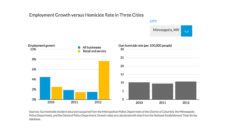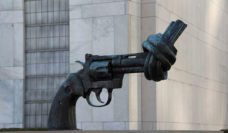Firearm violence in the United States is a public health issue of epidemic proportions. In 2014 alone, there were 33,599 firearm-related deaths. This is only 137 fewer deaths than the number attributed to motor vehicle crashes in the same year. Although this number is astronomical, there were an additional 80,000 non-fatal injuries.
The United States is a dramatic outlier among similar countries in this respect. Between 2003 and 2010, the U.S. accounted for over 80% of all firearm deaths in high income countries and over 90% of all children and youth (ages 0-24) firearm deaths. In addition, while other countries’ rates of firearm deaths decreased in this period, the U.S.’s remained stable. Tragedies involving firearms across the country have brought this issue into the forefront of American concerns.
Due to the deeply divisive political nature of firearms, there has not yet been substantial public policy action despite extensive media attention and public outcry. Partisan disagreements surrounding the interpretation of the Second Amendment often hinder policy action aimed at improving public safety in this area. While the discussion surrounding the constitutional framework of firearm ownership is crucial, one aspect of firearm violence that is independent of this debate is the high healthcare cost surrounding these injuries.
While the discussion surrounding the constitutional framework of firearm ownership is crucial, one aspect of firearm violence that is independent of this debate is the high healthcare cost surrounding these injuries.
We explored the cost and financial burden of the initial hospitalization for firearm-related injuries in the United States between 2006 and 2014. We found that over the study period, more than $6.6 billion dollars (and approximately $730 million dollars annually) was spent on the initial admission. Government insurance through Medicaid and Medicare covered over 40% of these costs, and another quarter of the costs were borne by uninsured individuals. Over 80% of uninsured individuals fell below the 50th income percentile.
These numbers significantly underestimate the true healthcare cost surrounding firearm violence in the U.S. They do not include the cost of hospital readmissions, rehabilitation, long term healthcare, time lost from work, or even emergency department care that does not lead to a hospital admission. In addition, given the often-insufficient reimbursement from uninsured patients with high cost injuries such as those from a firearm, the government often must subsidize trauma centers for them to remain solvent.
The high costs and cost burden of firearm injuries is borne not only by individuals injured with firearms but by the federal government and, thus, taxpayers. One approach to offsetting the high costs of these injuries to the public is creating or increasing an excise tax on the sale of all firearms and bullets as an appropriate public policy measure.
One approach to offsetting the high costs of these injuries to the public is creating or increasing an excise tax on the sale of all firearms and bullets as an appropriate public policy measure.
An excise tax is the traditional and universally accepted method used to push the costs imposed on society by certain activities back onto those who created them. Placing an excise tax on such “negative externalities,” as economists call them, is supported by both liberals and conservatives alike. Excise taxes on cigarettes have been described as “perhaps the single most important element” of policy in reducing tobacco use in the U.S. In addition, many conservative economists have called for a carbon tax to quell equivalent negative externalities related to the creation of pollution leading to greenhouse gasses. Excise taxes on firearms and bullets may be implemented at the city, state or federal level. Some cities, such as Seattle, have already implemented firearm excise taxes.
This firearm and bullet tax would help to offset the healthcare costs while simultaneously improving public safety, without infringing on the Second Amendment. We sincerely hope that bipartisan support for public health and improved firearm safety can allow for the U.S. to make progress in lowering our firearm injuries and fatalities to levels of our peer nations.
Feature image: Fonzi, melone, used under CC BY-NC 2.0














